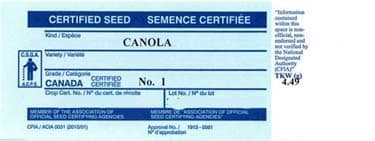
Informed decisions have to start with plant counts. Counting stubble density in the fall can help growers determine if their spring seeding rate was adequate to reach the crop’s yield potential. We know, based on analysis of stand establishment research, that canola generally needs a bare minimum of 4-5 plants per square foot to reach its yield potential.
But is this true for all varieties, all crop inputs packages, and all growing conditions? That is still being debated. Growers can start to figure out their own ideal target plant stand by collecting a few years’ worth of plant stand data and cross referencing it with yield. Compare plant density with yield/grade/maturity data for each field. Some growers may find that in a given year, 4 plants per square foot provides a satisfactory profit while other fields or other years may need a full 10 plants per square foot to satisfy profit and risk management requirements. By recording plant density and uniformity, you can see how they interact with yield, grade and maturity on your farm.
With this information, growers can start to run their own economics on seeding rates. They will be able to determine, for example, if a seeding rate higher than 5 lb./ac. does actually provide a strong return on investment if it means they’ll hit a target plant stand that works best on their farm. Or they may find that sticking with 5 lb./ac. but taking other steps to improve seed survival provides a better return. Or they find they can balance their seed cost and risk by planting heavier seed at 6 lb./ac. and lighter seed at 4 lb./ac. and achieve plant density targets without an overall increase in seed cost. They may also find an economic benefit from changing seeding rates during seeding based on individual field conditions — early cold soils, fields with heavier trash, etc.
It may take several years to compile enough data to be useful.
When comparing harvest plant stand counts to post-emergence counts, there is often a 10-15% drop in plant numbers through the season. (If there is an increase, which is also possible, take a close look at all plants in the harvest count to see how many are actually contributing to yield. Small spindly plants that emerged well after all the others may not have that many pods, and should not be included in the count.)
How to count: To do a stem count, growers can (1) count the stems per metre of row. Take that number and multiply by 100 then divide by the seed row spacing in cm to get plants per square metre. For example, 25 plants per metre multiplied by 100 then divided by 25 cm (10” row spacing) is 100 plants per square metre. Divide by 10 to get plants per square foot. Another way is to (2) use a hoop with an inside diameter of 56 cm. This is equivalent to 0.25 of a square metre. Count the stems inside the hoop, and multiply by 4 to get plants per square metre. Then divide by 10 if you want plants per square foot. Repeat counts a few times throughout the field.
Not just about yield. Growers may be able to achieve target yields over time with a lower seeding rate, but lower seeding rates do produce branchier plants that take longer to mature. This can increase the risk that fall frost will lock in high green counts. So while yield may be there, quality is not. In addition to later maturity, thin stands often mean a more varied maturity, which can make in-crop product applications (fungicide/insecticide/etc) more difficult to time.
Further reading:
Canola Digest: The right seeding rate
